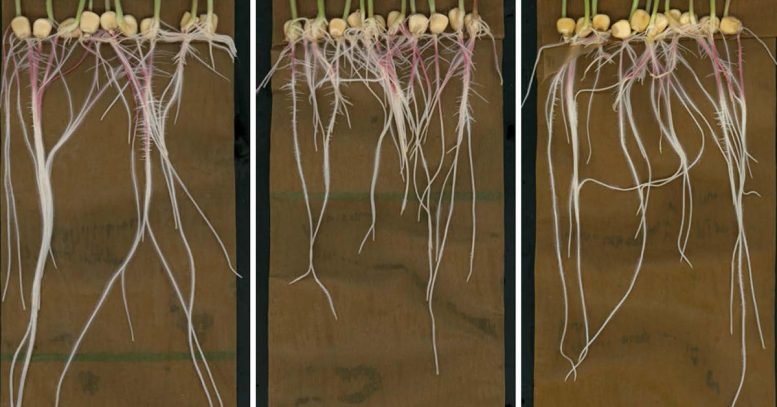
UC San Diego and Stanford scientists studied maize (corn) plant roots and their metabolites—molecules involved in the plant’s energy production—under different settings, including a control condition (left) and treated with aconitate (center) and succinate (right). Credit: Dickinson Lab, UC San Diego
Researchers have leveraged high-tech imaging originally designed for cancer research to gain fresh insights into the vital chemicals at work within plant roots. This groundbreaking research has led to the development of a chemical “roadmap” that holds significant implications for agricultural productivity, food creation, and climate resilience.
When casually strolling through a park on a sunny spring day, it’s easy to overlook the unseen complexities beneath the ground. Plant biologists, however, understand that the vast, meticulously structured root systems that exist underground are fundamental to the life and growth of plants. For instance, the intricate root networks of trees can stretch out underground just as extensively as the trees themselves reach skyward.
The research team, led by UC San Diego Biological Sciences Postdoctoral Scholar Tao Zhang and Assistant Professor Alexandra Dickinson, used an advanced imaging technology to investigate the roots of maize plants. They developed a “chemical roadmap” detailing the distribution of critical small molecules along the plant’s stem cells and their impact on the plant’s development. The study’s insights, published in the journal Nature Communications, could provide key insights into how these essential root chemicals affect plant growth.
“This chemical roadmap provides a resource that scientists can use to find new ways of regulating plant growth,” said Dickinson, a faculty member in the Department of Cell and Developmental Biology. “Having more information about how roots grow could be useful in conservation as we think about protecting our plants in natural environments and making them more sustainable, especially in agriculture.”
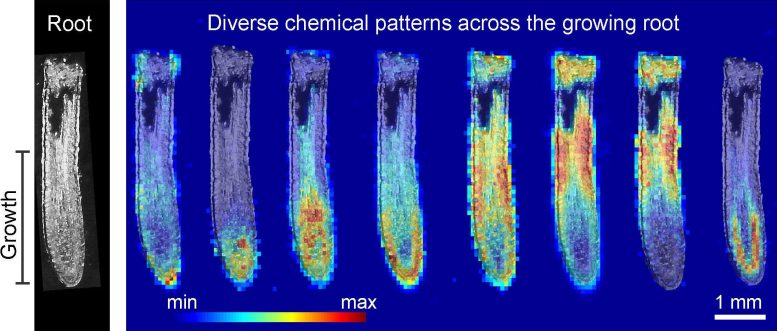
Researchers used an advanced imaging technology to develop a new understanding of essential root chemicals that are responsible for plant growth. Credit: Dickinson Lab, UC San Diego
While working as a visiting scientist at Stanford University, Dickinson began collaborating with study co-first author Sarah Noll and Professor Richard Zare, who developed a mass spectrometry imaging system that helps surgeons distinguish between cancerous and benign tissue during tumor-removal operations.
Dickinson, Zare, and Noll adapted the technology—called “desorption electrospray ionization mass spectrometry imaging” or DESI-MSI—to probe plant roots for the chemicals involved in growth and energy production. They initially focused on maize plants at the root tips, where stem cells play an active role in the plant’s development. Their method involved cutting through the center of the root to get a clear image of the chemicals inside.
“To help understand plant roots from the biology side, we needed to find out which chemicals are there,” said Zare. “Our imaging system sprays out droplets that strike different portions of the root and dissolve chemicals at that location. A mass spectrometer collects the droplet splash and tells us what those dissolved chemicals are. By systematically scanning the droplet target spot we make a spatial map of the root chemicals.”
The resulting images, believed to be some of the first to reveal the transition between stem cells and mature root tissue, show the foundational role of metabolites—molecules involved in the plant’s energy production. Tricarboxylic acid (TCA) cycle metabolites became the focus of the research since they were found to be a key player in controlling root development.
Coming into the study, the researchers expected a relatively uniform distribution of chemicals. Instead, with their chemical roadmap in hand, they found that TCA metabolites are clustered in patches across the root.
“I was surprised by how many chemicals are featured in really distinct patterns,” said Dickinson. “We can see that the plant is doing this on purpose—it needs these molecules in specific regions to grow properly.” The Dickinson lab showed that these TCA metabolites have predictable effects in development, not only in maize, but in another plant species as well (Arabidopsis). This is likely because TCA metabolites are highly conserved—they are made in all plants as well as animals.
Also emerging from the new images were previously unidentified chemical compounds. Dickinson says the mystery compounds could be critical for plant growth since they also are grouped in patterns at specific locations, suggesting a prominent role in development. Dickinson and her colleagues are now investigating these compounds and comparing varieties of maize that have different levels of stress resistance to adverse threats such as severe climate conditions and drought. The new information will help them develop novel chemical and genetic strategies for improving plant growth and stress resilience.
“We’re looking at different maize plants that have drought resistance to see if we’ve already found chemicals that are specific to that variety that we haven’t seen in other varieties,” said Dickinson. “We think that could be a way to find new compounds that can promote growth, especially in harsh conditions.”
Reference: “Chemical imaging reveals diverse functions of tricarboxylic acid metabolites in root growth and development” by Tao Zhang, Sarah E. Noll, Jesus T. Peng, Amman Klair, Abigail Tripka, Nathan Stutzman, Casey Cheng, Richard N. Zare, and Alexandra J. Dickinson, 4 May 2023, Nature Communications.
DOI: 10.1038/s41467-023-38150-z
The study was funded by the National Science Foundation, the National Institutes of Health, the Hellman Foundation, the William E. McElroy Charitable Foundation, the Revelle Provost Summer Research Scholarship, and the Genentech Scholars Program.


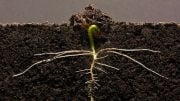


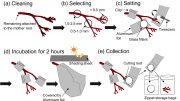


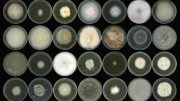
Be the first to comment on "Chemical Cartography: Mapping the Hidden World of Plant Roots"